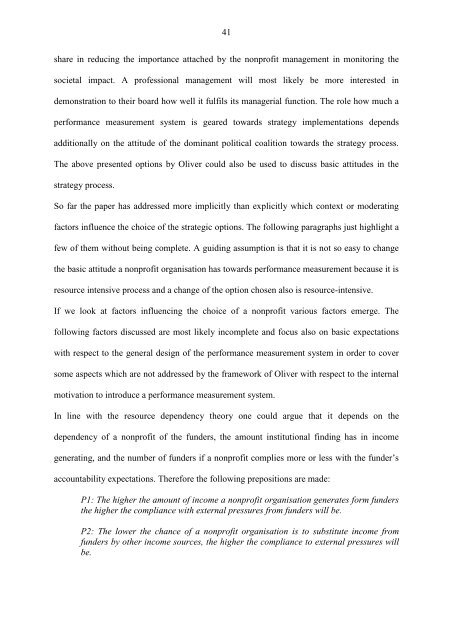Strategic responses to Performance Measurement in Nonprofit ...
Strategic responses to Performance Measurement in Nonprofit ...
Strategic responses to Performance Measurement in Nonprofit ...
You also want an ePaper? Increase the reach of your titles
YUMPU automatically turns print PDFs into web optimized ePapers that Google loves.
41<br />
share <strong>in</strong> reduc<strong>in</strong>g the importance attached by the nonprofit management <strong>in</strong> moni<strong>to</strong>r<strong>in</strong>g the<br />
societal impact. A professional management will most likely be more <strong>in</strong>terested <strong>in</strong><br />
demonstration <strong>to</strong> their board how well it fulfils its managerial function. The role how much a<br />
performance measurement system is geared <strong>to</strong>wards strategy implementations depends<br />
additionally on the attitude of the dom<strong>in</strong>ant political coalition <strong>to</strong>wards the strategy process.<br />
The above presented options by Oliver could also be used <strong>to</strong> discuss basic attitudes <strong>in</strong> the<br />
strategy process.<br />
So far the paper has addressed more implicitly than explicitly which context or moderat<strong>in</strong>g<br />
fac<strong>to</strong>rs <strong>in</strong>fluence the choice of the strategic options. The follow<strong>in</strong>g paragraphs just highlight a<br />
few of them without be<strong>in</strong>g complete. A guid<strong>in</strong>g assumption is that it is not so easy <strong>to</strong> change<br />
the basic attitude a nonprofit organisation has <strong>to</strong>wards performance measurement because it is<br />
resource <strong>in</strong>tensive process and a change of the option chosen also is resource-<strong>in</strong>tensive.<br />
If we look at fac<strong>to</strong>rs <strong>in</strong>fluenc<strong>in</strong>g the choice of a nonprofit various fac<strong>to</strong>rs emerge. The<br />
follow<strong>in</strong>g fac<strong>to</strong>rs discussed are most likely <strong>in</strong>complete and focus also on basic expectations<br />
with respect <strong>to</strong> the general design of the performance measurement system <strong>in</strong> order <strong>to</strong> cover<br />
some aspects which are not addressed by the framework of Oliver with respect <strong>to</strong> the <strong>in</strong>ternal<br />
motivation <strong>to</strong> <strong>in</strong>troduce a performance measurement system.<br />
In l<strong>in</strong>e with the resource dependency theory one could argue that it depends on the<br />
dependency of a nonprofit of the funders, the amount <strong>in</strong>stitutional f<strong>in</strong>d<strong>in</strong>g has <strong>in</strong> <strong>in</strong>come<br />
generat<strong>in</strong>g, and the number of funders if a nonprofit complies more or less with the funder‟s<br />
accountability expectations. Therefore the follow<strong>in</strong>g prepositions are made:<br />
P1: The higher the amount of <strong>in</strong>come a nonprofit organisation generates form funders<br />
the higher the compliance with external pressures from funders will be.<br />
P2: The lower the chance of a nonprofit organisation is <strong>to</strong> substitute <strong>in</strong>come from<br />
funders by other <strong>in</strong>come sources, the higher the compliance <strong>to</strong> external pressures will<br />
be.
















